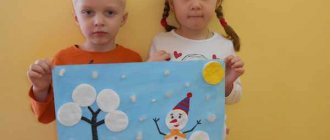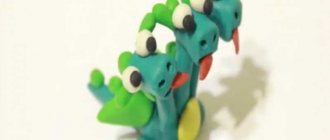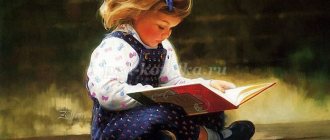Preview:
Summary of educational activities for theatrical activities in the senior group “We are actors.”
arouse interest in theatrical and play activities, create a sense of success for each individual child;
consolidate the types of theaters (drama, puppet, continue to introduce theatrical terminology (actor, director, drama theater, gapit); - introduce the theater puppet on gapit, teach basic skills of controlling a puppet;
cultivate a friendly, emotionally positive attitude towards each other;
activating children's speech through the development of dialogical speech (conversation, game, dramatization game, introduction of new words and concepts into the active vocabulary (puppeteer, gapit, actor).
Dictionary: drama theatre, puppet theatre, gapit, theatrical mask, director.
Material: screen, dolls on the gap 10 pcs. , tape recorder, audio cassettes, theatrical masks on a stick. (sad and cheerful).
(children enter the group to the music)
-Let's stand in a circle. Let's smile at each other, and so that the sun smiles at us, let's draw it with our hands: Let's draw a big circle,
Lots of rays around
This sun is shining
It illuminates everything.
“Now the room has become brighter and more joyful from our sunshine.” Now come over to the chairs, sit down comfortably, and I will tell you what we will do. Let's cancel our activity and just make small magical transformations!
- Well, do you agree? That's great!
- Guys, where do magic and wonderful transformations happen? (in a fairy tale).
- Do you like fairy tales?
— What do you like more, listening or watching fairy tales and plays?
-Where can you see them? (in the theatre) .
— Guys, are there theaters in our city?
— What theaters do you know? (dramatic, puppet)
— Guys, who shows performances, fabulous performances in the drama theater? (People)
— Do you know what these people in the theater are called? (actors)
— Actors play different roles. They can turn into anyone on stage! They can play a stupid king or a capricious princess. Or they can turn into a small helpless puppy or a cowardly bunny.
- Do you want us to try to turn into someone? Come to me, stand up wherever you want. And for a moment you and I will become actors in a drama theater, imagine that we are on stage, and here are the spectators. So, the music started playing and we were no longer kids, but kittens! The kittens got out of the warm house into the snowy yard, sniffed the cold air, and then it started snowing! Kittens don't like it! They curled up into a ball, pressing their paws, ears, and tails. But the snow stopped, the kittens straightened up, shook off their front paws, back paws, ears, tail and all their fur.
- Oh, what great fellows you are, real kittens!
- And now you are no longer kittens, but snowmen that the guys made during a walk! Snowmen love frosty days, they have fun, they smile! But then the sun began to warm up, the snowmen began to melt! First the head melted, then the arms, then the body and the snowmen turned into clean, transparent puddles.
- Well done guys, you are real actors!
- Well, now you can sit down on the chairs, relax and see what I have prepared for you. (I take out 2 masks, a happy one and a sad one)
- What is this, guys? (masks)
— That’s right, masks, but not ordinary carnival masks, but theatrical ones.
-Are they the same or different? (different)
— What mood do they convey? (happy and sad)
- Now, guys, you can come up, take any mask for yourself and we will stand in a circle.
— Look carefully at your mask, remember what mood it conveys. And we'll try on our masks
- Oh, you’re completely unrecognizable!
- Now, dear masks, you can tell what mood you are in, conveying it with your voice, and maybe even with your movement.
- Please, dear mask, tell me what kind of person you are? (I'm a happy mask)
If the mask is cheerful, it talks about it cheerfully, joyfully, cheerfully, and may even perform some funny movement!
- What about you, mask? (I'm a sad mask)
The sad mask has a sad voice, gestures and movements also express sadness. - And now all the sad masks, take a step in a circle and turn to the cheerful masks. And I invite the masks to greet each other.
— The cheerful masks will greet the sad ones first. Exciting and fun! “Hello, sad mask! ”
- And now the sad masks. Quiet and sad. “Hello, funny mask! ”
- May I greet you?
“Hello, dear masks! ” (making a mistake in intonation) - Did I convey the mood of the mask correctly in my voice?
- Why is it wrong?
- You guys are great! It was impossible to recognize you behind the masks!
They conveyed the mood of the mask wonderfully with their voice and movement! Now you can put the mask down and rest a little.
— Guys, we talked about the drama theater and even were actors ourselves, but we completely forgot about another theater, which one? (puppet)
— Guys, who is the most important person in the puppet theater?
— Does anyone help the dolls or do they perform independently on the stage or screen?
—What do you call people who are controlled by dolls?
- They are called Puppeteers! Repeat and remember this word, because today you will hear it often.
- And all because I have prepared a surprise for you!
- Today we ourselves will be puppeteers, because theatrical puppets are looking forward to seeing you in our puppet theater! Want to meet them? Then meet me!
— These dolls perform on a screen, they are called dolls on the gap.
— What is gapit? This is a stick on which the doll is put, the stick is called - GAPIT. That’s where the name comes from - dolls on gapite!
- Today I will teach you how to control these dolls, because you will be puppeteers. We take the gapit in one hand, and with the other hand we hold the wires that are attached to the doll’s hands, we can raise and lower them, the doll will come to life in your hands.
The role of theatrical activities
Due to the fact that theatrical activities are based on play, it is easy for a preschooler to understand the tasks that are assigned to him. He can easily create the image of his character, give him character and live his life with him. The child develops imagination and thinks more broadly.
theatrical performance
Attention! Participation in theatrical productions allows one to identify a creative personality at a very early age, thanks to which parents can develop the child in a direction that is interesting to him, which can become the basis for successful self-realization in adulthood.
With the help of theatrical performances, children activate their vocabulary, improve the change in intonation while pronouncing lines, and practice constructing dialogues.
Types of theatrical activities
Theatrical games in the senior group can be divided into two main types: dramatic and directorial. Children begin to master the second on their own when they play with toys: they control plush performers, speak for them, move them, and build relationships between toys.
The dramatic type of activity involves the child’s independent performance as an artist using various techniques of expressive speech.

Children as artists
Open classes
Open lessons on theatrical activities attract children with their naturalness. In the improvised auditorium sit not only familiar children and teachers, but also invited guests - parents and other teachers. The purpose of such a lesson is to demonstrate children’s involvement in art, the children’s ability to clearly and distinctly pronounce lines, and not be embarrassed by the audience.
Most often, such classes use costumes created by children together with their parents. Each child who takes part in the formation of his image becomes more closely connected with his character and is sensitive to his fate.
How to learn letters correctly with a child 3-5 years old
Attention! Sometimes it is enough to let a preschooler decorate the mask of his hero so that he feels responsible for the fate of the character.
In some preschool institutions, during music classes, children are given cards with images of characters. Having each received their role, the guys play “Turnip”, “Kolobok” or “Teremok” to the accompaniment.
Drama games
Dramatizations allow preschool children to reveal their directing abilities. One student can control several characters at once, and children are often so carried away that they involuntarily adjust the intonation of their voice individually for each character. During such performances, children learn the significance of emotions and practice their facial and intonation demonstration. The definition of character is fixed - all the heroes in the fairy tale are different, each with their own temperamental characteristics.
It is not uncommon for teachers to put on several theatrical performances each season, reinforcing the study of nature and weather patterns through play. For example, in winter, children are invited to dramatize the process of preparing various animals for wintering: some fill bins with food, insulate their homes; others gorge themselves and hibernate, while others go to warmer climes.
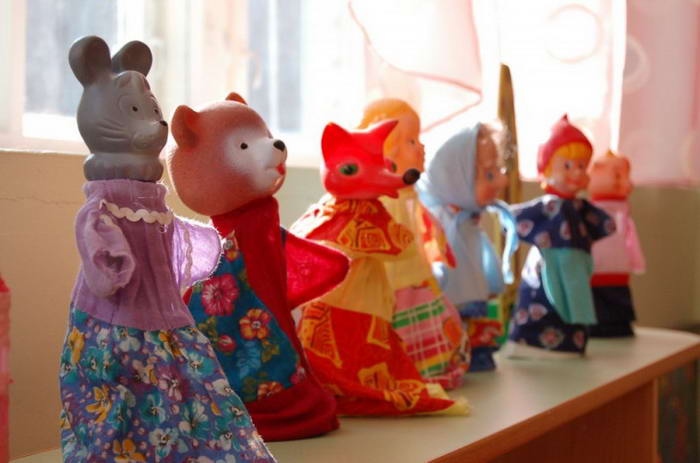
Toy range for director's play
Self-analysis in planning theater activities
Experienced teachers, before drawing up an art teaching project for a year or a season, conduct a survey of parents, from which they learn about the degree of emotional liberation of the children, the clarity of the child’s speech at home, the ability to use facial expressions and gestures during communication and the inclinations to empathy .
After conducting the survey, the teacher becomes clear which aspects should be paid more attention to and which ones less when compiling a card index of theatrical games in the group.
Important! Self-analysis reveals the main directions in which the selected material should be worked on and identifies weaknesses in the emotional development of children.
Theater project in the senior group
Play theater should be a constant presence in children's lives. To do this, teachers keep notes on theater activities, where they distribute various types of performances, evenly distributed throughout the academic year.
The results of the lessons in the garden are:
- communicative development of children of different ages;
- familiarization with the history of the origin of the theater and its purpose;
- joint creation of props and stage images;
- increasing parents' attention to the creative activities of preschoolers;
- creating a screen for further use by children in independent theatrical performances.
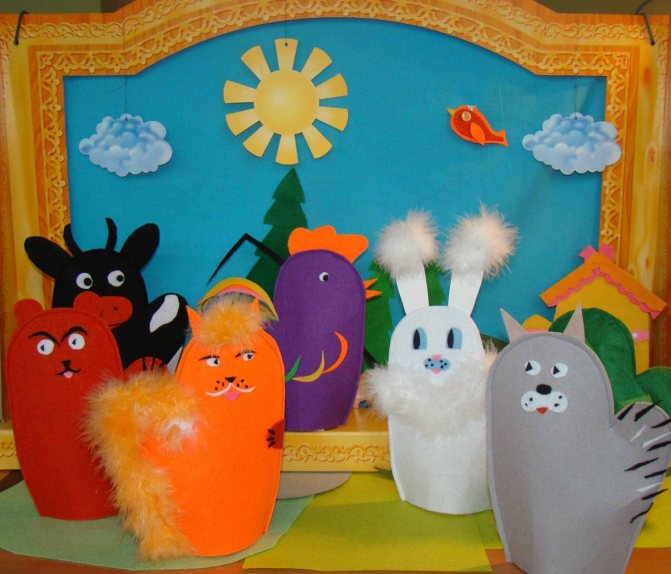
Making your own actors
The theater design should reflect the needs of children's development in accordance with their age characteristics. Often, children need to give free rein to their imagination to organize their own theatrical performance. So, children 4-5 years old can quite successfully put on a show using only spoons. A healthy imagination is enough to mentally endow each spoon with appearance, character, and create a fictional image. Even at the stage of self-analysis, teachers find out the pupils’ ability to think outside the box, leaving the child, as if by accident, alone at the table with two or three spoons. Some children begin to get bored over time and look in the direction of their frolicking peers, while others, already in the first minute, take up spoons and begin to play with them like dolls.
Classification of pedagogical technologies in preschool education
Additional Information! Children who are unable to create instruments for play from everyday objects using their imagination especially need theater, which will allow them to develop non-standard thinking and relieve them of emotional constraint.
MAGAZINE Preschooler.RF
Creative work “Theatrical activities in kindergarten for children of senior preschool age”Teacher's pedagogical experience:
Tereshchenko N.N., Vad village
Municipal preschool educational institution kindergarten "Romashka"
Modern preschool institutions are looking for new humanistic, person-centered approaches to education. Today, many teachers are concerned about finding unconventional ways to interact creatively with children. How to make every activity with a child interesting and exciting, to simply and unobtrusively tell him about the most important thing - about the beauty and diversity of this world, how interesting it is to live in it? How to teach a child everything that is useful to him in this complex modern life? How to educate and develop his basic abilities: to hear, see, feel, understand, fantasize and invent?
The relevance of this problem is determined by the fact that the development of creative abilities in children contributes to the comprehensive development of the child’s personality and increases the opportunities for his further education. One of the most popular and exciting areas in preschool education is theatrical activities. It is theatrical activities that make it possible to solve many pedagogical problems related to the formation of the expressiveness of a child’s speech, intellectual and artistic-aesthetic education. By participating in theatrical games, children become participants in various events from the lives of people, animals, and plants, which gives them the opportunity to better understand the world around them. At the same time, theatrical play instills in the child a sustainable interest in his native culture, literature, and theater. The educational value of theatrical games is also enormous; children develop a respectful attitude towards each other, they learn the joy associated with overcoming communication difficulties and self-doubt.
My main goal is to develop the creative abilities of children through the means of theatrical art. Theatrical activity develops the child’s personality, instills a sustainable interest in literature and theater, improves the skill of embodying certain experiences in play, and encourages the creation of new images.
Tasks:
- To consolidate children’s ideas about various types of puppet theaters, to be able to distinguish them and name them (table theater, toy theater, shadow theater, mitten theater, etc.)
- To develop children’s speech with the help of puppet theater, to improve the ability to convey the emotional state of characters through facial expressions, gestures, and body movements.
- Develop memory, thinking, imagination, attention of children.
Expected results:
- Enrich children's vocabulary with nouns, adjectives, adverbs.
- Increase children's speech activity.
- Encourage students to speak in complete sentences and write fairy tales.
- Develop elements of creativity and initiative; with the help of the teacher, participate in the staging and dramatization of folk tales.
- To instill in children an interest and love for fiction.
The use of non-traditional forms in theatrical activities:
- Non-traditional form of conducting classes (the content of such classes is not only familiarization with the text, but also with gestures, facial expressions, movements, costumes)
- The use of bright, non-traditional subject equipment for the lesson: a set of soft modules as decorations that allow you to change the plot of the theatrical performance, non-traditional materials for the production of various types of theater.
I have been working on this topic for three years. I started my work by selecting different types of theaters. Then she actively began to use theater in her classes, staging theatrical performances with children. The guys in my group showed such fairy tales as “Turnip”
,
“Kolobok”
,
“The Tale of the Cockerel”
,
“Geese and Swans”
,
“How the Hares Built a House” (appendix)
.
Chapter 1. Puppet theater as an art form
1. 1. Puppet theater in kindergarten
Theater is one of the most democratic and accessible forms of art for children. It allows you to solve many pressing problems of modern pedagogy and psychology related to:
- art education and raising children.
- formation of aesthetic taste.
- moral education
- development of personal communicative qualities.
- education of will, development of memory, imagination, fantasy and speech.
- creating a positive emotional mood, relieving tension and conflicts through play.
Theater not only reveals the spiritual and creative potential of a child, but also gives him a real opportunity to adapt in the social sphere. It has a great influence on the comprehensive development of the child’s personality.
From pedagogical practice it is clear that children most of all love to play with theatrical dolls, show performances, and improvise. Playing with a theatrical doll, the child, on behalf of the hero, talks about his thoughts and feelings; with the help of the doll, he can express and regulate his own experiences. By playing with dolls and interacting with other people, timid children begin to understand the process of communicating with peers and as adults, they will be able to behave differently and, depending on the situation, show persistence.
Modern children do not have a sufficient understanding of the life of their ancestors, their way of life, traditions and customs. Folk festivals and fun occupied a very noticeable place in the life of the Russian people. The foundations of the future professional theater were born in the fair festivities. Studying the history of Russian culture and participating in performances will help children better understand the traditions of their people.
Puppet theater is an art that children are introduced to at an early stage of their lives and is a favorite children's show. Children are often afraid of Santa Claus, Bear and other characters performed by actors on the stage of theaters, but they enjoy playing with toys that depict them as small. Accustomed to the small size of toys, they are not afraid of the wolf or Baba Yaga, they even shake their fingers and drive them away. Therefore, a puppet theater for little ones even has some advantages over a theater in which human artists perform. It has long become a necessary component in the life of our kindergarten “Romashka”
.
What is the importance of puppet theater for the development of preschool children?
- Our puppet theater influences young spectators with a whole range of artistic means. When showing puppet theater performances, both the artistic word and a visual image are used: a doll, picturesque and decorative design, a song, and musical accompaniment.
- The professional use of puppet theater is of great help in everyday work with children for the development of mental, moral, and aesthetic education in children. Creates a good mood for children, enriches them with impressions, evokes emotions in them, promotes the development of patriotism and artistic education. The happy smiles, sparkling eyes and joyful faces of our children during the performance convincingly demonstrate how much children love puppet theater and eagerly await the opening of the curtain.
- Its educational value is very important. During the preschool period, the child begins to develop character, interests, and attitude towards the environment. It is at this age that it is very useful to show children examples of friendship, kindness, love for Russia, honesty, truthfulness, hard work, to show tears and laughter, and the way of modern life.
- Puppet theater, by its nature, is close and understandable to young children and therefore has a huge emotional impact on them. On the stage of our theater they see familiar and favorite dolls and toys. When the “come to life” dolls begin to move and speak, they transport children to a completely new, fascinating world, the world of living toys, where everything is unusual, everything is possible and attractive.
- Music is an important component of the performance and aesthetic education of children. It sets off, sets the character and rhythm of each character, each mise-en-scène, and emphasizes the rhythmic movements of the dolls and their mood. A puppet theater performance does not take place without the singing and dancing of puppets, which children love and know very much. Music shapes, gives volume and charisma to the performance. Familiar melodies and songs bring children and heroes closer together. It is very good when children themselves sing a song with the hero and dance during a break in the performance along with the heroes, performing familiar movements in games and dances.
You can start introducing children to puppet theater from the first junior group. Teachers and older preschoolers show small performances to the kids, using various types of theaters for this purpose: picture theater, bi-ba-bo theater.
By the end of the year, children of the first junior group, having accumulated some experience, try to independently participate in a puppet show. This desire must be supported, developed and strengthened. A finger theater is suitable for this purpose.
For children of the second youngest group, the simplest and most accessible theater is a puppet theater on the table.
In the middle group we move on to more complex theater. We introduce children to the theater screen and to riding dolls and puppets.
In the older group, you should introduce children to puppets, show them dolls with a “living hand”
.
1. 2.Types of puppet theaters
In our kindergarten we make and use puppets ourselves in working with children in the following types of puppet theater:
- picture theater
- theater on flannelgraph
- table theater
- theater of boxes, balls, cylinders.
- finger theater
- mitten theater
- toy theater
- Bi-ba-bo theater
- shadow theater
Picture theater, flannelgraph theater and table theater - it is the easiest to make and display. Kids can draw and cut out such a theater themselves. They will draw pictures, silhouettes and come up with their own stories for them. Everything here is flat and the dolls and decorations, the flannelgraph, are shown on a special board (covered with flannel)
, tabletop theater - on a stage-table.
Everything is available cut out of paper or cardboard. The purpose of such theaters is to add variety to play in groups, to make the toy more interesting for them, to entertain and please children with something made with their own hands. Games with flannelgraph develop creative abilities and contribute to their aesthetic education. Little children love to look at pictures in books, but if the pictures are shown to be moving and actionable, they will enjoy it even more (application)
.
The toy theater is all three-dimensional. The toys used are ordinary children's ones, bought in a store, plus various things may be needed for display: dishes, a basket, a crib. It is desirable that all toys be of the same texture. Such a presentation helps to create a more vivid perception and develops children’s spatial and figurative vision. The content of the scene should be extremely simple, without movements and actions that are difficult for toys to perform. To show that the toy is walking, we move it slowly forward; if it is running, move it faster. During the show, you should sit calmly in front of the audience, look at the operating toy, do not make unnecessary movements and avoid unnecessary facial expressions, so as not to distract attention from what is happening on stage, do not keep your free hand on the table, but immediately remove it (application)
. Goal: to improve the ability to convey the emotional state of characters using puppeteering techniques.
Theater of boxes, balls, cylinders - children make themselves from ready-made materials: boxes and balls. All that remains is to draw or glue - eyes, noses, ears, horns, bows and aprons, hooves and shoes. And what is needed for a little fairy tale. The children themselves will offer a lot of interesting things while working (application)
. The purpose of such theaters is to add variety to the game, make the toy more interesting for children, entertain and delight them with something made with their own hands.
Theater of fingers - small bags made of fabric and placed on children's fingers. These bags have elements of animals and the image of people (application)
. Goal: develop fine motor skills of the hands, improve gestures.
Theater of mittens - children's mittens and gloves. No need to overload with real details (application)
. Goal: to develop the ability to drive dolls, independently invent movements to create an image, and develop fine motor skills.
Bi-ba-bo theater - the doll is put on the hand, where the index finger is the head, and the fingers on the right and left are the hands (application)
.
Goal: to consolidate the skills of controlling dolls with a “living hand”
, enrich children’s vocabulary, and develop clear and correct diction.
Shadow theater is silhouettes of plots and puppets, cut out of cardboard and covered with black ink (application)
. Goal: to develop children’s imagination, teach them to interact collectively and consistently with each other, showing their individuality.
In order for puppet performances to be professionally bright, we adults first learn to use theatrical puppets ourselves. The stage of our theater is a screen. The action of puppets and scenery takes place on it. Behind the screen are the puppeteers with their puppets with attributes for the performance.
1. 3. Theatrical games
Theatrical art is close and understandable to children, because the basis of theater is play. As children develop independence, more and more new ideas for theatrical games emerge, the impetus for the development of which are fairy tales, short stories, stories, cartoons, which arouse the desire to play with their vivid images and interesting plots. Play is the most accessible and interesting way for a child to process and express impressions, knowledge and emotions. In theatrical play, emotional development occurs: children get acquainted with the feelings and moods of the characters, master the ways of their external expression, and understand the reasons for this or that mood. Theatrical play is also of great importance for speech development (improving dialogues and monologues, mastering the expressiveness of speech)
. Finally, theatrical play is a means of self-expression and self-realization for the child.
The characteristic features of theatrical games are the literary or folklore basis of their content and the presence of spectators. They can be divided into two main groups: dramatizations and directorial ones.
In dramatization games, the child plays a role as an “artist”
, independently creates an image using a set of means of verbal and non-verbal expressiveness. Types of dramatization are:
- games that imitate images of animals, people, literary characters;
- role-playing dialogues based on text;
- staging of works; staging performances based on one or more works;
- improvisation games with the acting out of a plot (or several plots)
without prior preparation.
In director's play, “the actors are toys or their substitutes, and the child, organizing the activity, is a “scriptwriter and director”
, manages
the “artists”
.
“Voicing”
the characters and commenting on the plot, he uses different means of verbal expression. The types of director's games are determined in accordance with the variety of theaters used in kindergarten.
Theatrical activities simultaneously perform cognitive, educational and developmental functions.
By participating in theatrical games, children learn about the world around them and become participants in events in the lives of people, animals and plants. The themes of theatrical games can be varied.
The educational value of theatrical games lies in the formation of a respectful attitude of children towards each other and the development of collectivism. Particularly important are the moral lessons of fairy-tale games that children receive as a result of a joint analysis of each game.
Theatrical games develop children's creative activity. Children become interested when they not only speak, but also act like fairy-tale characters.
In theatrical play, children imitate the movements of the characters, while their coordination is improved and a sense of rhythm is developed. And movements, in turn, increase the activity of the speech-motor analyzer.
From game to game, children’s activity increases, they memorize the text, transform, enter into character, and master the means of expression. Children begin to feel responsible for the success of the game.
Speaking in front of the audience, children overcome shyness and embarrassment and mobilize their attention. All these qualities will have a beneficial effect on the child’s educational activities at school and will help him feel confident among his peers.
So, theatrical play is one of the most effective ways to influence a child, in which the learning principle is most clearly manifested: learn by playing!
Chapter 2. Theatrical activity as a process of interaction, communication and learning
2. 1.Theatrical activities as a priority direction of my teaching activity
It is important to introduce the little man to theater, literature, and painting from early childhood. The sooner you start, the greater results you can achieve. Working in the kindergarten "Romashka"
, I chose theatrical activity as one of my priority areas.
Starting from the 2nd junior group until graduation, I teach children the basics of acting and at the same time introduce them to various types of puppet theaters. For this purpose, I use artistic and finger games, games for the expressiveness of movements, their plasticity and coordination.
| Next > |

